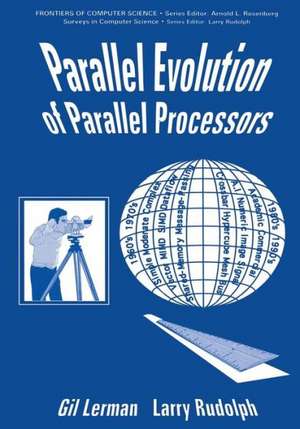Parallel Evolution of Parallel Processors: Evaluation in Education and Human Services
Autor G. Lerman, L. Rudolphen Limba Engleză Paperback – 17 mar 2013
Din seria Evaluation in Education and Human Services
- 18%
 Preț: 952.57 lei
Preț: 952.57 lei -
 Preț: 387.96 lei
Preț: 387.96 lei - 15%
 Preț: 641.71 lei
Preț: 641.71 lei - 15%
 Preț: 707.63 lei
Preț: 707.63 lei -
 Preț: 388.52 lei
Preț: 388.52 lei -
 Preț: 384.86 lei
Preț: 384.86 lei - 15%
 Preț: 648.56 lei
Preț: 648.56 lei -
 Preț: 382.95 lei
Preț: 382.95 lei - 15%
 Preț: 645.60 lei
Preț: 645.60 lei -
 Preț: 387.96 lei
Preț: 387.96 lei -
 Preț: 397.16 lei
Preț: 397.16 lei -
 Preț: 387.75 lei
Preț: 387.75 lei -
 Preț: 388.52 lei
Preț: 388.52 lei -
 Preț: 389.88 lei
Preț: 389.88 lei - 15%
 Preț: 643.34 lei
Preț: 643.34 lei -
 Preț: 383.33 lei
Preț: 383.33 lei - 15%
 Preț: 584.76 lei
Preț: 584.76 lei - 15%
 Preț: 648.24 lei
Preț: 648.24 lei - 18%
 Preț: 1224.68 lei
Preț: 1224.68 lei - 18%
 Preț: 958.38 lei
Preț: 958.38 lei -
 Preț: 392.21 lei
Preț: 392.21 lei - 15%
 Preț: 644.30 lei
Preț: 644.30 lei - 15%
 Preț: 646.43 lei
Preț: 646.43 lei - 18%
 Preț: 1231.64 lei
Preț: 1231.64 lei -
 Preț: 388.72 lei
Preț: 388.72 lei - 18%
 Preț: 1227.04 lei
Preț: 1227.04 lei - 15%
 Preț: 646.43 lei
Preț: 646.43 lei -
 Preț: 394.12 lei
Preț: 394.12 lei - 15%
 Preț: 644.95 lei
Preț: 644.95 lei - 15%
 Preț: 650.19 lei
Preț: 650.19 lei -
 Preț: 390.25 lei
Preț: 390.25 lei
Preț: 335.52 lei
Preț vechi: 419.39 lei
-20% Nou
Puncte Express: 503
Preț estimativ în valută:
64.20€ • 67.03$ • 53.13£
64.20€ • 67.03$ • 53.13£
Carte tipărită la comandă
Livrare economică 04-18 aprilie
Preluare comenzi: 021 569.72.76
Specificații
ISBN-13: 9781461362371
ISBN-10: 1461362377
Pagini: 288
Ilustrații: XIII, 270 p.
Dimensiuni: 178 x 254 x 15 mm
Greutate: 0.5 kg
Ediția:Softcover reprint of the original 1st ed. 1993
Editura: Springer Us
Colecția Springer
Seria Evaluation in Education and Human Services
Locul publicării:New York, NY, United States
ISBN-10: 1461362377
Pagini: 288
Ilustrații: XIII, 270 p.
Dimensiuni: 178 x 254 x 15 mm
Greutate: 0.5 kg
Ediția:Softcover reprint of the original 1st ed. 1993
Editura: Springer Us
Colecția Springer
Seria Evaluation in Education and Human Services
Locul publicării:New York, NY, United States
Public țintă
ResearchCuprins
1. Introduction.- 2. Classification of Parallel Processors.- 2.1. A Brief History of Classification Schemes.- 2.2. The Classification Scheme Used in This Work.- 2.3. A Look at the Classification Characteristics.- 2.4. Information-Gathering Details.- 2.5. An Apology.- 3. Emergent Trends.- 3.1. Applications.- 3.2. Mode of Control.- 3.3. Data Exchange and Synchronization.- 3.4. The Number and Type of PEs.- 3.5. Interconnection Network.- 3.6. Memory Organization.- 3.7. Type of Constructing Institution.- 3.8. Period of Construction.- 3.9. Summary of the Correlations.- 4. Popular Machine Models.- 4.1. Exposing the Complex Patterns.- 4.2. General-Purpose Machines.- 4.3. Model IV — Image (and Signal) Processing SIMD Machines.- 4.4. Model V — Database MIMD Machines, Two Variants.- 4.5. Trends in Commercialization.- 5. The Shape of Things to Come?.- 5.1. Underlying Assumptions.- 5.2. Applications.- 5.3. Control.- 5.4. Data Exchange and Synchronization.- 5.5. Number and Type of PEs.- 5.6. Interconnection Networks.- 5.7. Memory Organization.- 5.8. Sources.- 5.9. Classification of Parallel Computers.- 5.10. Summary.- Appendix: Information about the Systems.

























